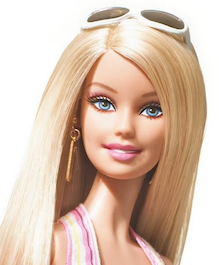The Rise of Barbie and Rambo
- FATHER DWIGHT LONGENECKER
Signs within the developing culture from the 1950s indicated, even then, a new confusion about sexual identity.
 From the dawn of time a man was defined as a father, or potential father. A woman was a mother, or potential mother. The whole delicate dance of courtship and sexual relationships circled around the undeniable link between sex and procreation. But if a woman was not a mother, and if a man was not a father, what were they?
From the dawn of time a man was defined as a father, or potential father. A woman was a mother, or potential mother. The whole delicate dance of courtship and sexual relationships circled around the undeniable link between sex and procreation. But if a woman was not a mother, and if a man was not a father, what were they?
I have been doing some research for a play I want to write dramatizing the meeting between the English poet Edith Sitwell and Marilyn Monroe. Thinking further about the impact of Monroe on popular culture brought me to the realization that she was even more of an icon and goddess than the popular clichés might suggest. My essay on the subject is here.
Marilyn Monroe epitomizes a major cultural shift in the objectification of women as sex objects. Women have always been the object of male desire, but down through history, sex was linked with fertility. While there have always been prostitutes, in Monroe (and before her Mae West, Jean Harlow, and a street full of other Hollywood vamps) the screen siren went mainstream. In my previous essay I observed how it was Monroe's nude calendar shots that propelled Hugh Hefner's 1956 publication of Playboy magazine.
At the same time, the early 1950s, eugenicist Margaret Sanger raised money for the development of the contraceptive pill, which was legalized in 1960. As the sexual act was separated from procreation, women were separated from motherhood. In 1959, at the American International Toy Fair, the Mattel company launched the Barbie doll. It was an instant success. Marketed as a "teen aged fashion model" Mattel sold over 350,000 units in the first year alone.
Far be it from me to be curmudgeonly about a child's toy, but on the other hand, what exactly is child-like about the Barbie doll? With her pneumatic chest and pouting expression, if she is a teenager her name is Lolita. In fact, Ruth Handler, the creator of the Barbie doll, borrowed the idea from a German doll named Bild Lilli. The Lilli doll was based on a comic strip character drawn for the Bild newspaper. Bild Lilli was "a blonde bombshell, a working girl who knew what she wanted and was not above using men to get it." In other words, she was a German Marilyn Monroe.
Playtime is practice for adulthood, and when girls played house and tucked their baby dolls into bed they were preparing for their future roles as wives and mothers. What were they modeling when they played with Barbie?
Like Marilyn, Barbie symbolized a shift in the cultural understanding of women and their role. Before 1959, little girls played with baby dolls not Barbie dolls. Playtime is practice for adulthood, and when girls played house and tucked their baby dolls into bed they were preparing for their future roles as wives and mothers. What were they modeling when they played with Barbie? They were modeling models, and not just fashion models, but a new kind of model American woman — one who was not primarily a wife and mother, but a busty clothes horse who reveled in a full closet, a dream home, a flashy sports car, and Ken.
The third Toy Story film features a hilarious send up of Barbie and Ken. Barbie is a ditzy blonde who gets all excited when she meets Ken who is portrayed as a campy gay man. Like most satire, it bites because it's true. If Barbie was "a blonde bombshell, a working girl who knew what she wanted and was not above using men to get it," Ken was not a husband and father. He was the typical suntanned, gay boyfriend.
I don't for a moment imagine that any of this was intentional. Instead Barbie and Ken reflected the shift in sexual roles and behaviors taking place in the wider society during the 1960s and 70s. With the introduction of artificial contraception, women became sterile sex objects and men became their emasculated fashion accessories.
In seeming response to this distortion of femininity, the culture coughed up a distorted version of masculinity. The gay liberation movement introduced the handsome gay model while Hollywood sold the "action hero." As Barbie and the Hollywood starlets were overly inflated female figures, the heroes in films like Rambo and The Terminator were overly inflated, aggressively masculine killing machines.
The signs within the developing culture from the 1950s onward indicate, even then, a new confusion about sexual identity. From the dawn of time a man was defined as a father or a potential father. A woman was a mother or a potential mother. The whole delicate dance of courtship and sexual relationships circled around the undeniable link between sex and procreation. Once that natural bond was broken, the natural understanding of sexual identity was also broken and the seeds of gender confusion were planted.
The only recourse is for individual men and women to observe what is happening and take the simple, beautiful, common sense step of getting married, staying married, and having lots of children.
If a woman was not a mother, what was she? At first she was a bombshell, a sex object or a fashion model. If a man was not a father, what was he? He was a muscle-bound, machine gun blasting macho man. However, before long the homosexualists and feminists answered the false images with new sexual types: the gay man and the tough woman. Within those subcultures more types emerged. Gender confusion has now stepped up a notch so we are told there are umpteen genders and anyone must be able to choose among an ever-bewildering and expanding list.
What can be done about such distortion of the human person? Not much. Pandora's Box has been opened and the demons have been released.
The only recourse is for individual men and women to observe what is happening and take the simple, beautiful, common sense step of getting married, staying married, and having lots of children. That way the young man's masculinity will be affirmed in fatherhood. The woman's femininity will be affirmed in motherhood. Within that relationship their humanity will be affirmed and completed and their happiness may just be the example and the antidote to the current sickness.
 This is Meaghen Gonzalez, Editor of CERC. I hope you appreciated this piece. We curate these articles especially for believers like you.
This is Meaghen Gonzalez, Editor of CERC. I hope you appreciated this piece. We curate these articles especially for believers like you.
Please show your appreciation by making a $3 donation. CERC is entirely reader supported.

Acknowledgement
 Father Dwight Longenecker. "The Rise of Barbie and Rambo." The Imaginative Conservative (January 9, 2020).
Father Dwight Longenecker. "The Rise of Barbie and Rambo." The Imaginative Conservative (January 9, 2020).
Reprinted with permission from The Imaginative Conservative. See the original article here.
The featured image is "1960 Pepsi-Cola Advertisement Life Magazine February 15 1960" by SenseiAlan, and is licensed under CC BY 2.0.
The Author
 Father Dwight Longenecker serves as the pastor of Our Lady of the Rosary parish in Greenville, South Carolina. Father Longenecker studied for the Anglican ministry at Wycliffe Hall, Oxford and served for ten years in the Anglican ministry as a curate, a chaplain at Cambridge and a country parson. In 1995 he and his family were received into full communion with the Catholic Church. He is the author of more than twenty books including: Beheading Hydra, Praying the Rosary for Inner Healing, Listen My Son: St. Benedict for Fathers, More Christianity, Challenging Catholics: A Catholic Evangelical Dialogue, St. Benedict and St. Therese: The Little Rule & the Little Way, Mary: A Catholic-Evangelical Debate, and The Path to Rome. You can follow his writings, listen to his podcasts, join his online courses, browse his books, and be in touch at DwightLongenecker.com.
Father Dwight Longenecker serves as the pastor of Our Lady of the Rosary parish in Greenville, South Carolina. Father Longenecker studied for the Anglican ministry at Wycliffe Hall, Oxford and served for ten years in the Anglican ministry as a curate, a chaplain at Cambridge and a country parson. In 1995 he and his family were received into full communion with the Catholic Church. He is the author of more than twenty books including: Beheading Hydra, Praying the Rosary for Inner Healing, Listen My Son: St. Benedict for Fathers, More Christianity, Challenging Catholics: A Catholic Evangelical Dialogue, St. Benedict and St. Therese: The Little Rule & the Little Way, Mary: A Catholic-Evangelical Debate, and The Path to Rome. You can follow his writings, listen to his podcasts, join his online courses, browse his books, and be in touch at DwightLongenecker.com.




